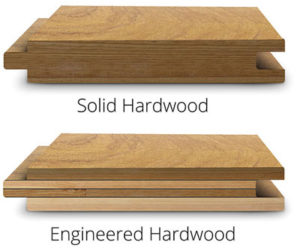 Engineered Hardwood
Engineered Hardwood
Unlike a solid three-quarter inch thick hardwood, engineered hardwood is a product that consists of several layers. The top layer is a hardwood veneer, a thin slice of wood (less than 1/8″) of whatever species you desire. The inner layers are made of plywood, high density fiberboard, or hardwood. The core layers make the product more stable than regular hardwood, while the outer veneer gives it it’s beauty.
Pros:
- Engineered hardwood flooring is designed to reduce the moisture problems associated with conventional hardwood.
- Its layers block moisture and provide added stability to your floor.
- Engineered flooring will not swell or warp, making it very low maintenance.
Environmental Advantages of Engineered Hardwood
Choosing engineered flooring is considered more environmentally-friendly than traditional hardwood for a few reasons.
Veneer is sliced rather than cut with a saw. This process produces no sawdust, which means that all of the tree’s wood can be used. The sawdust produced making hardwood boards is wasted wood (and adds up to a significant amount).
Hardwood trees grow much more slowly than the trees used to make engineered flooring cores. Because more surface area is produced making veneer, installing traditional hardwood uses many times the amount of slow growing tree. This makes the replenishing time much longer.
Engineered Hardwood Flooring Cons
There are, in actuality, very few drawbacks to this type of hardwood flooring, but this doesn’t make it a foolproof project or even the right floor for every application. Comparable to solid hardwood in terms of cost, engineered wood floors are still considerably more expensive than laminate, tile, and carpet.
Solid Hardwood
As the words say, it is a solid piece of wood, directly from the tree. It’s the old standard from many years ago before the development of engineered hardwood. Typically manufactured with a tongue and groove for board alignment, the installation is typically left to the professionals.
Installation
Solid. Hard. Those words give the impression that solid hardwood flooring is an indestructible material, suited for all places in the house. Let’s look at various parts of the house and how they are suited for hardwood installation:
- No. Basements, also known as below-grade locations, are a poor choice due to the high moisture content.
- Dining, Bedroom, Living, etc.: Yes. All at-grade or above-grade locations, with the possible exception of the locations listed below, are excellent choices.
- Kitchens: Possible. Solid hardwood can work in kitchens, but many homeowners choose to install more moisture-resistant surfaces such as tile or resilient flooring.
- Bathrooms: Not recommended. Too much moisture.
There are many widths of hardwood to choose from. Depending upon the desired affect, you can choose from 2″ to a plus 6″ width. Roth Carpet & Flooring experts will help you decide on what flooring choice is best for you. Call today for an appointment, 866-919-7684.
